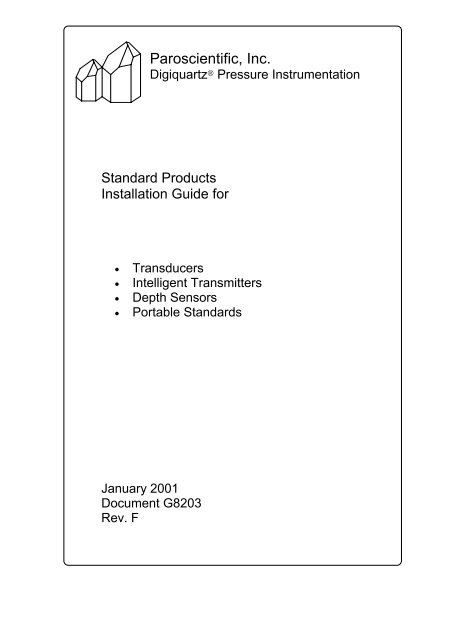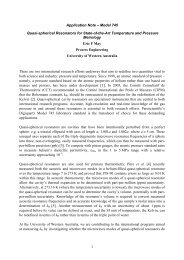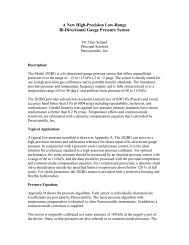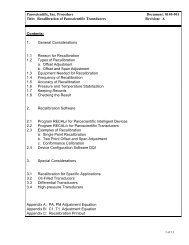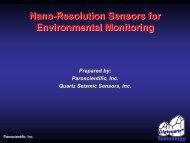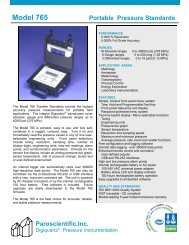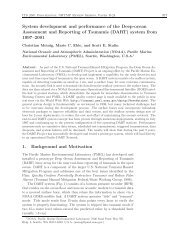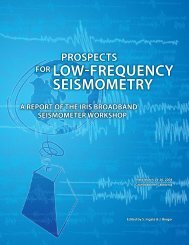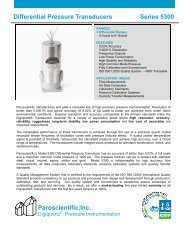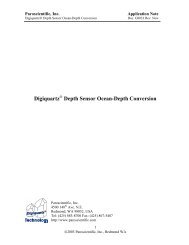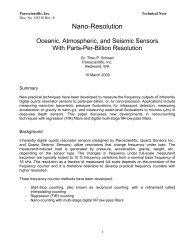Paroscientific, Inc.
Paroscientific, Inc.
Paroscientific, Inc.
Create successful ePaper yourself
Turn your PDF publications into a flip-book with our unique Google optimized e-Paper software.
<strong>Paroscientific</strong>, <strong>Inc</strong>.Digiquartz ® Pressure InstrumentationStandard ProductsInstallation Guide for• Transducers• Intelligent Transmitters• Depth Sensors• Portable StandardsJanuary 2001Document G8203Rev. F
<strong>Paroscientific</strong>, <strong>Inc</strong>.Digiquartz ® Pressure InstrumentationFEATURES• 0.01% Accuracy• 0.0001% Resolution• Environmentally Rugged• Low Power Consumption• Temperature Compensated• Highly Reliable and StableAPPLICATION AREAS• Metrology• Hydrology• Aerospace• Meteorology• Oceanography• Process Control• Nuclear Industry• Energy Exploration• Lab Instrumentation<strong>Paroscientific</strong>, <strong>Inc</strong>.,4500 148th Avenue N.E.Redmond, WA 98052 U.S.A.Tel: (425) 883-8700Fax: (425) 867-5407Internet: www.paroscientific.comE-mail: support@paroscientific.com
Digiquartz® Installation GuideThank you for your recent Digiquartz® purchase. This manual isintended to offer installation and start up suggestions for all models ofDigiquartz® Pressure Transducers, Transmitters, Depth Sensors andPortable Standards.Additional product, installation, and operating information is availableon the Internet at www.paroscientific.com.General informationHandlingAll Digiquartz® products are precision instruments. Please handlewith care. Do not drop, or allow tools to fall on the transducer orpressure port. Excessive mechanical shock may cause nonrepairabledamage. Do not over-pressure the transducer. Alltransducers are designed for specific operating ranges. Pressuresexceeding 1.2 times the operating range may cause non-repairabledamage.Documents<strong>Inc</strong>luded with your new <strong>Paroscientific</strong> Digiquartz® transducer are acopy of the Specification Control Drawing appropriate to the model orseries of transducer, calibration coefficients in psi and degrees C(unless otherwise specified), and a certificate of calibration traceableto NIST.The calibration coefficients are unique to each individual transducer.If this data is lost or missing, send a fax or e-mail request to<strong>Paroscientific</strong> with the serial number of the transducer.For additional information on installation and communications withintelligent transmitters, refer to the Programming and OperationsManuals:For Series 1000, 6000, 8000, and 9000: Doc. No. 8819-001For Models 730, 740, 760, 761, and 790: Doc No. 8107-0011
Software SupportDigiquartz® Interactive (DQI) is a Windows-based software programthat can set-up, configure, and diagnose Intelligent Instruments. Theprogram can display data from all <strong>Paroscientific</strong> instruments equippedwith RS-232 interface. It also includes a terminal emulation programto send direct commands to the instruments and receive and displayits response.Digiquartz® Assistant (DQA) is a Windows-based data acquisitionprogram. It samples and records the response of up to eightDigiquartz® instruments that are equipped with an RS-232 interface.The program supports data acquisition of pressure, temperature,frequency output, and humidity (MET3 products). The data ispresented on a virtual instrument panel with graphical output.Digiquartz® Terminal is a Windows-based terminal program that isdesigned for use with Intelligent Transmitters, Standards, and DepthSensors.Software support is available on the Digiquartz® CD Library, whichalso includes product information and technical application notes.This CD is included free of charge with each intelligent product order,and is also available for download from our web site atwww.paroscientific.comMounting TransducersDigiquartz® transducers may be mounted and used in anyorientation. Mounting hole patterns for each of our models are foundon the Specification Control Drawing (SCD).Pressure head effects, particularly with fluid-filled pressure lines,affect the zero offset calibration of the sensor. These effects can beminimized by mounting all components at the same level or bymaking an offset correction after the transducers are installed. Makesure to purge all bubbles from fluid-filled lines.Pressure Ports and Buffer TubesParker A-lok or equivalent nut and ferrule fittings are used on most<strong>Paroscientific</strong> Transducers, Transmitters, and Pressure Standards.The Series 1000, 2000 and 6000 devices use the 1/8" ODconfiguration and the Series 3000 and 4000 use the 1/16" ODconfiguration.2
TransducerBuffer tubeThe coiled buffer tube, either nylon or stainless steel, is an integralpart of the mechanical shock protection system of the transducer.Please handle with care.Two 7/16" wrenches are required when making or breaking any 1/8inch OD fittings: one wrench to stabilize the transducer side and theother wrench to turn the fitting.High pressure transducers (Series 3000 and Series 4000) use the1/16" OD Parker A-lok or equivalent fittings. Two 5/16" wrenches arerequired to make and undo these connections.Series 9000 High Pressure Absolute Intelligent Transmitters use aHIP 60-21HF4 fitting. Maximum torque on HIP Fittings is 25 footpounds.When installing a buffer tube, it is recommended that they should beinstalled finger tight, then tightened an additional ¾ turn to completethe pressure seal.Try to make all of your pressure connections to the last nut andferrule on the buffer tube. If the first nut and ferrule (near thetransducer) become flared, stripped or damaged, it may be necessaryto return the unit to the factory for repairs.Oil-Filled Pressure Ports and Buffer TubesTransducers that are intended to be used to measure fluid pressuresare oil-filled at <strong>Paroscientific</strong>. If your transducer and buffer tube areoil-filled, do not pull a vacuum on the lines. This procedure couldallow bubbles to form in the pressure lines and transducer, which willadversely effect the accuracy of the device. Oil fill and bleed allpressure lines that are to be connected to an oil-filled transducer withDow Corning FS-1265 Silicone Fluid. At 25° C this fluid has a specificgravity of 1.25 and a viscosity of 300 centistokes.3
Transducer Electrical CharacteristicsThe basic Digiquartz® transducers, Series, 2000, 3000, 4000, and5300, provide frequency output signals for pressure and temperature.The nominal pressure signal frequency is a 10% change within theband of 30 kHz to 42 kHz. The temperature signal is a nominal 45ppm/°C sensitivity within the band of 168 kHz to 172 kHz. Theyoperate from 6 to 25 VDC at 1.3 mA and are reverse polarityprotected.Current drain increases when driving long lines or low impedances.Refer to the SCD supplied with the transducer for any special inputpower options or considerations.Standard wire color code for a basic Digiquartz® transducer is asfollows:REDBLACKBLUEWHITE6 to 25 VDCSignal and power groundPressure signal, 30 to 42 kHzTemperature signal, 168 to 172 kHzThe pressure and temperature signal wires are configured as twistedpairs. Each signal line is twisted with a negative (black) wire tominimize cross coupling between the temperature and pressuresignals. If the signal lines are to be extended, the black wires shouldbe continued and twisted with the signal wire at a rate of 4 to 5 turnsper inch.4
Intelligent TransmittersSeries 1000, 6000, and 9000 Intelligent Transmitters feature dual RS-232 and RS-485 serial ASCII interfaces and provide outputs directlyin the user’s choice of pressure units. All transmitters have 15-pinhigh-density male D-subminiature connectors. These devices canalso drive a remote Model 715 display. The Intelligent transmittersoperate from external DC power, 6 VDC to a maximum of 16 VDC.Current drain varies from 3 mA to 30 mA, depending on the samplerate. Power module kits are available to adapt to 110 and 220 voltsources. Reference Operation Manual, Doc. No. 8819-001.Please refer to the Specification Control Drawing (SCD)accompanying each unit for special features and options.Intelligent Standards and DisplaysThe Model 740 and 760 Intelligent Standards and the Model 730Intelligent Display feature RS-232 serial ASCII interfaces and provideoutputs directly in the user’s choice of pressure units. All intelligentstandards and displays have 9-pin D-subminiature connectors. Whenconnecting to a 9-pin computer interface, a straight ribbon cableconnection may be used between the Model 730, 740, or 760 and astandard 9 pin serial COM port and a PC. A null modem is notnecessary. Reference the Programming and Operation Manual, Doc.No. 8107-001 for details.The Models 730 and 740 operate from external DC power, 5 VDC toa maximum of 25 VDC. Current consumption varies from 12 mA to25 mA, depending on the sample rate. The Model 730 and 740 willrun on the internal set of 4 AA batteries for up 70 hours. Powermodule kits are available to adapt to 110 and 220 VAC sources. Theexternal AC adapter supplied with these units is for AC operation onlyand does not recharge the batteries. Reference Programming andOperation Manual, Doc. No. 8107-001.The Model 760 Portable Field Standard has an internal 6V sealedlead acid battery with a capacity of 3 ampere hours. Battery life forthe Model 760 is up to 200 hours. The Model 760 internal batterycharger will trickle charge the battery whenever it is connected to ACpower. The internal charger will not allow the battery to overchargeand may be left on indefinitely.The first indication of a low battery is a decimal point between eachdigit on the display. The second indication is a set of dashed linesthat will slowly fade as the battery is discharged.5
Low battery indicationsDo not rely on the data displayed or transmitted when either of theselow battery signals is present. Replace the batteries in the Model 730or 740 or use the AC adapter. The Model 760 battery may berecharged by connecting the 760 to AC power.Please refer to the Specification Control Drawing (SCD)accompanying each unit for special features and options.Remote DisplayThe Model 715 is a 2-line, 16-character backlit alphanumeric displaythat is compatible with all Digiquartz® transducers that have dual RS-232 and RS-485 serial interfaces. It displays pressure withengineering units, and can optionally display alphanumeric text,internal transmitter temperature, or pressure as a percentage of fullscaleby means of a horizontal bar graph. Digiquartz® transducerscommunicate with the Model 715 via either RS-232 or RS-485.Depth SensorsMost <strong>Paroscientific</strong> Digiquartz® transducers are available in asubmersible depth sensor configuration.During installation, it is very important to have a bubble-freeinterface between the depth sensor pressure port and the outsidewater pressure. The pressure ports of <strong>Paroscientific</strong> depth sensorsare vacuum oil filled with Dow Corning FS 1265 silicone fluid. Thisfluid has a specific gravity of 1.25 and a viscosity of 300 centistokesat 25° C. The oil in the pressure port should be visible beforedeploying.Depth Sensors and Deep Ocean InstallationsThe Series 8CDP depth sensors are packaged in a machined PVC oracetal pressure enclosure and are available for depths to 700 meters.Output communications options are frequency signals or RS-232/RS-485 serial ASCII interfaces The Series 8CB depth sensors arepackaged in a machined 316L stainless steel enclosure, and modelsare available for depths to 7000 meters.Refer to the Specification Control Drawing (SCD) supplied with theunit for appropriate electrical and mechanical connections.6
Depth Measurement ConsiderationsThe conversion of pressure to depth depends on:1. The local value of gravity.2. The atmospheric pressure at the surface.3. The average fluid density between the pressure transducer andthe surface.4. The compressibility of the fluid. (significant at depths greaterthan 50 m)The local value of gravity, g local , varies by 0.5% over the face of theearth. This value depends primarily on latitude and altitude. Thereare also smaller corrections for local anomalies. Gravity can bemeasured at a site with a geodetic survey. If accuracy of 0.02% isadequate, local gravity can be determined from the followingequation:g local = 978.0309 + 5.18552 sin 2 Φ -0.0057 sin 2 (2Φ) -0.00009406 hwhere Φ is latitude and h is the altitude in feet.(ref. K.R. Lang Astrophysical Formulae 1980)Example: at Φ = 55 degrees and altitude h=2000 feet, the calculationgives g local = 981.317.Fluid density must be accurately known to obtain accurate depths.Fresh water density depends on temperature and varies byapproximately 0.5% between 0 and 30 degrees C. Typical values arebetween 0.995 and 1.000 gm/cm 3 .Salt water density depends on both temperature and salinity. Thesevalues generally change significantly with depth. Typical oceanvalues at depths less than 500 meters are between 1.02 and 1.03gm/cm 3 , but lower values may be found in coastal regions wheninfluenced by river outflow. In addition, water compresses at greatdepth so that a further correction must be made. A typical nearsurfacevalue is approximately 1.028 gm/cm 3. Never use anapproximate density value of 1.0 when computing depth in salt water.The result will be in error by nearly 3%.If the calculations of depth from pressure are done carefully, depthbelow the sea surface can be determined with an accuracy of betterthan 0.01%. However, the sea surface moves up and down with timebecause of tides, and this must be allowed for in referencing to asurvey datum. Conversion factors for density=1.000 gm/cm 3 andg=980.665 are tabulated as follows:7
M of H 2 O cm of H 2 O f in. of H 2 O ft of H 2 O0.7030696 70.30696 27.67991 2.306659The conversion factors for other values of density and g local may beobtained by multiplying the above factors by:1.0000 X 980.665density g localExample: for a salt water density of 1.0281 and a local gravity of981.3184 cm/s 2 , the conversion factor from psi to feet of depth wouldbe 2.242120.Intelligent transmitters can read out directly in depth if the appropriateconversion factor is entered with the UF command. Please refer tothe Operation Manual, Doc. No. 8107-001 or 8819-001 for details.Depth Sensing and Depth Measurement in Fixed InstallationsSensing and measuring depth in a fixed installation can also beaccomplished with a gauge model (two port) depth sensor. Gaugedepth sensors have a vent tube port located in the electricalconnector. This tubing runs inside of the cable to the surface and isvented to atmosphere. The vent tube line must be kept dry and mayrequire a desiccant at the open end. The advantage of a gaugesensor in this application is the automatic compensation for localbarometric pressure changes.Non-contact depth sensing can be accomplished by using a<strong>Paroscientific</strong> gauge sensor in a bubbler configuration. In thisapplication, the PS-2 Water Stage Sensor is not deployed in the water(or tank fluids) and both pressure ports are dry. Dry gas is regulatedand slowly released through tubing in the tank or reservoir. The gaspressure required to send a bubble through this system is equal tothe pressure above the end of the tubing.8
Depth is determined by multiplying the pressure by a conversionfactor. Water density, local gravity and the transducer height abovethe bubbler orifice should be accounted for when developing theconversion factor for your installation. Refer to <strong>Paroscientific</strong> PS2Bubbler System Document T8694 with accompanying software.CalibrationCalibration intervals are not specified. Your application and theoperating environment will determine the calibration interval. Annualcalibration to verify or maintain the calibration is a generally acceptedpractice. RECAL software and instructions are available in<strong>Paroscientific</strong> document RECAL Doc. 8140-001.The original factory calibration establishes a baseline for the life of thetransducer. Additional calibration events are modifications of thisbaseline. A single point zero adjustment calibration will account fornormal component aging. A more detailed zero and span adjustmentcalibration can be used if the unit has experienced over-pressureconditions.Factory calibration services are available. Contact the <strong>Paroscientific</strong>Service Department for information.When installing new calibration coefficients or if a new transducer isconnected to an intelligent instrument or card, do not alter the TCvalue that was originally installed in the memory. The TC value isunique to the time base on the board and is not part of the transducercalibration coefficients.9
WarrantyAll Digiquartz® products come with a limited 5 year warranty with thefirst two years covered at 100%.For additional information on <strong>Paroscientific</strong> products, contact yourlocal Digiquartz® representative or application engineers at:<strong>Paroscientific</strong>, <strong>Inc</strong>.4500 148th Avenue N.E.Redmond, WA 98052 U.S.ATel:(425) 883-8700Fax:(425) 867-5407Web site:E-mail:www.paroscientific.comsupport@paroscientific.com10
To obtain →multiplynumberof ↓ byfactorMeters ofwater(density =1.0 gm/cm 3 )Pounds/inch 2(psi)Pressure Conversion Factors<strong>Inc</strong>hes ofMercury(in Hg)mm ofMercury orTorr(mm Hg)Gram/cm 2(gm/cm 2 )Millibars(mbar)(hPa)Newton/meter 2(Pascal)(Pa)Meters of water 1 1.422334 2.895903 73.55592 100.0000 98.06650 9806.650Pounds/inch 2 0.7030696 1 2.036021 51.71493 70.30696 68.94757 6894.757<strong>Inc</strong>hes of Mercury 0.3453155 0.4911541 1 25.40000 34.53155 33.86388 3386.388mm of Hg, Torr 0.01359510 0.01933678 0.03937008 1 1.359510 1.333224 133.3224Gram/cm 2 0.01000000 0.01422334 0.02895903 0.7355592 1 0.9806650 98.06650Millibars 0.01019716 0.01450377 0.02952999 0.7500617 1.019716 1 100.0000Newton/m 2 1.0197161.450377 2.952999 7.500617 0.01019716 0.01000000 1x 10 -4 x 10 -4 x 10 -4 x 10 -3Pressure to Depth Conversions*m of H2O m of H2O in. of H2O ft. of H2O m of seawater d=1.0281*ft. of seawater d=1.0281*m of aird=0.00177*in. of aird=0.00177*1 psi = 0.7030696 70.30696 27.67991 2.306659 0.683853 2.243613 600.9143 23658.04*Conversion factors should be adjusted for the average density and local gravity. Please refer to page 7-8 of Doc. G8203International Standards Convenient Conversions1 mbar = 1000 dyne/cm 2 1 kPa = 1000 Pa 1Mpa = 1000 kPa1 inch = 2.54 cm exactly 1 bar = 1000 mbarStandard gravity = 980.665 cm/sec 2 1 psi = 144 lb/ft 21 atmosphere = 1013.25 mbar exactly 1 kg/cm 2 = 1000 gm/cm 21 pound of mass = 453.59237 gm exactly 1 Torr = 1.0 mm Hg = 1000 microns Hg1 atmosphere = 760 mm Mercury exactly by definition 1 in Hg = 2.54 cm Hg = 25,400 microns Hg


